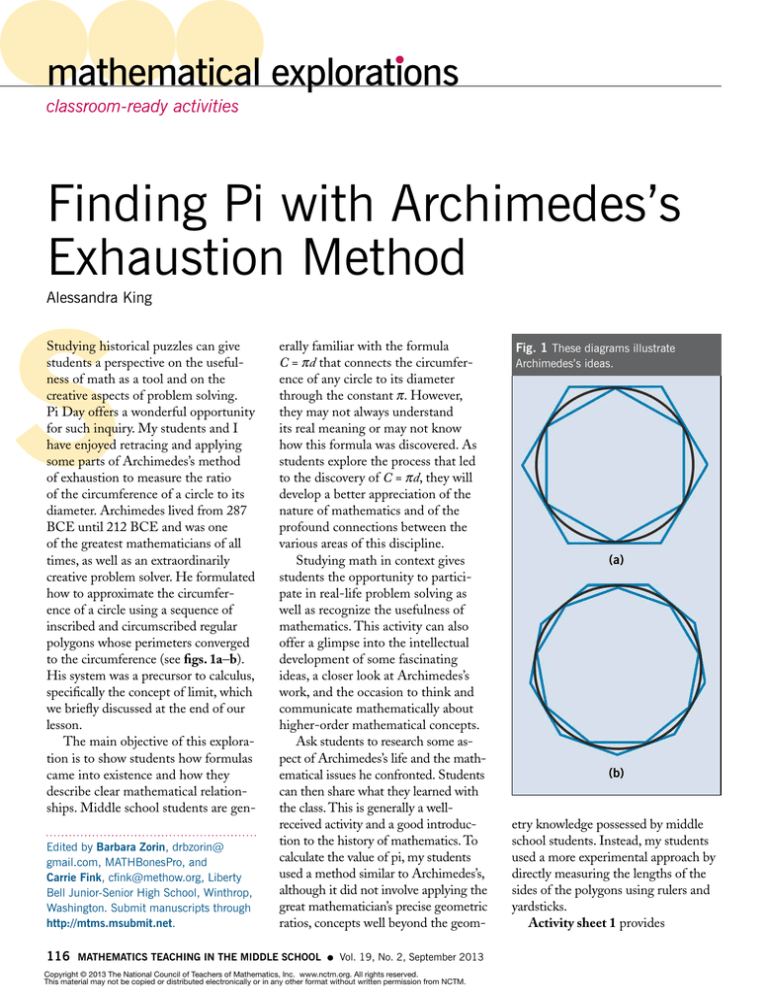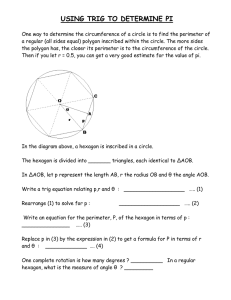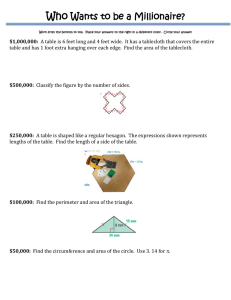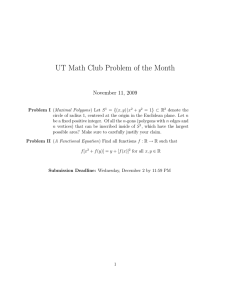
mathematical explorations
classroom-ready activities
Finding Pi with Archimedes’s
Exhaustion Method
s
Alessandra King
Studying historical puzzles can give
students a perspective on the usefulness of math as a tool and on the
creative aspects of problem solving.
Pi Day offers a wonderful opportunity
for such inquiry. My students and I
have enjoyed retracing and applying
some parts of Archimedes’s method
of exhaustion to measure the ratio
of the circumference of a circle to its
diameter. Archimedes lived from 287
BCE until 212 BCE and was one
of the greatest mathematicians of all
times, as well as an extraordinarily
creative problem solver. He formulated
how to approximate the circumference of a circle using a sequence of
inscribed and circumscribed regular
polygons whose perimeters converged
to the circumference (see figs. 1a−b).
His system was a precursor to calculus,
specifically the concept of limit, which
we briefly discussed at the end of our
lesson.
The main objective of this exploration is to show students how formulas
came into existence and how they
describe clear mathematical relationships. Middle school students are genEdited by Barbara Zorin, drbzorin@
gmail.com, MATHBonesPro, and
carrie Fink, cfink@methow.org, Liberty
Bell Junior-Senior High School, Winthrop,
Washington. Submit manuscripts through
http://mtms.msubmit.net.
116
erally familiar with the formula
C = pd that connects the circumference of any circle to its diameter
through the constant p. However,
they may not always understand
its real meaning or may not know
how this formula was discovered. As
students explore the process that led
to the discovery of C = pd, they will
develop a better appreciation of the
nature of mathematics and of the
profound connections between the
various areas of this discipline.
Studying math in context gives
students the opportunity to participate in real-life problem solving as
well as recognize the usefulness of
mathematics. This activity can also
offer a glimpse into the intellectual
development of some fascinating
ideas, a closer look at Archimedes’s
work, and the occasion to think and
communicate mathematically about
higher-order mathematical concepts.
Ask students to research some aspect of Archimedes’s life and the mathematical issues he confronted. Students
can then share what they learned with
the class. This is generally a wellreceived activity and a good introduction to the history of mathematics. To
calculate the value of pi, my students
used a method similar to Archimedes’s,
although it did not involve applying the
great mathematician’s precise geometric
ratios, concepts well beyond the geom-
MatheMatics teaching in the Middle school
●
Vol. 19, No. 2, September 2013
Copyright © 2013 The National Council of Teachers of Mathematics, Inc. www.nctm.org. All rights reserved.
This material may not be copied or distributed electronically or in any other format without written permission from NCTM.
Fig. 1 These diagrams illustrate
Archimedes’s ideas.
(a)
(b)
etry knowledge possessed by middle
school students. Instead, my students
used a more experimental approach by
directly measuring the lengths of the
sides of the polygons using rulers and
yardsticks.
Activity sheet 1 provides
guidelines on how to replicate this
process in a classroom. After sharing
some information about Archimedes
and breaking into groups, students
drew a circle using a string of fixed
length (the radius) tied to a clasp at
the center. To make students’ calculations easier, we chose radii equal to
1/2 foot, 1/2 yard, or 1/2 meter so
that the length of the circumference
would (theoretically) equal pi—feet,
yards, or meters, respectively. Then
the students inscribed a regular
hexagon. First, they chose a point on
the circumference. Then, with the
compass open and using the same
radius, they pointed the compass at
their chosen point and drew a semicircle that cut the circumference at
two more points.
The students used their rulers and
connected each point on the circumference with the center of the circle.
They then extended the segment to
reach the circumference on the other
side of the center, producing three
more vertices. They next connected
the vertices by drawing a regular hexagon. The students took turns measuring the six sides of the polygon and
recorded and added their data, determining the perimeter of the polygon
and an estimate of the length of the
circumference. Then, the averages of
the measurements found by each student in a group were added; the group
mean—their first approximation of
p—was then calculated. Each student
used table 1 to track results, and each
group collected the data from each
member in table 2.
The students then doubled the
number of sides of the polygon to obtain a dodecagon. They produced this
shape by drawing (or constructing,
for the more advanced students) the
perpendicular bisector of each side.
(This line intersects the circumference
at one point, a vertex of the inscribed
regular dodecagon.) Once all the vertices were created and connected, the
Table 1 Each student used a grid to track and organize the inscribed polygon data.
Type of Polygon
No. of
Sides
Length of
Sides
Average
Length
Perimeter
Value of p
Hexagon
Dodecagon
24-gon
Table 2 Each group’s inscribed polygon data were also contained in a table.
Type of Polygon
No. of Sides
Perimeters
Average
Perimeter
Value of p
Hexagon
Dodecagon
24-gon
students again measured the perimeter
of the dodecagon using the same procedure outlined above. Some groups
doubled the number of sides to construct and find the perimeter of a 24gon (see fig. 2). Using Archimedes’s
method in its entirety, the students
could also construct circumscribed
polygons. This part of the activity, and
the corresponding approximation of p,
is described in activity sheet 2.
Activity sheet 3 invites students
to think in depth about Archimedes’s
procedure for approximating p and
to ponder its creativity and meaning.
I found that students realized that as
the number of sides of the inscribed
and circumscribed polygons increases,
Archimedes’s procedure would produce a lower and an upper limit for
the value of p. Students concluded
that as the number of sides increases
indefinitely, the perimeter of the polygons approaches the circumference,
and their area, the area of the circle.
The Reflections section can also
help assess students’ learning. In our
Vol. 19, No. 2, September 2013
●
Fig. 2 Some groups doubled the
number of sides to construct and find
the perimeter of a 24-gon.
case, we discussed the activity in class
as a group, thus providing a good
gauge of the students’ understanding.
It also helped clarify their thoughts and
ideas. Each student could then write
their answers and submit them either
individually or as a group. To promote
this activity, students’ descriptions and
Mathematics Teaching in the Middle School
117
Fig. 3 The variation in the readings and measurement errors often surprised students.
extension activities (available online).
In closing, my students responded
enthusiastically to this exploration,
which provided a very intuitive and
logical introduction to basic concepts
of calculus, such as that of limit. This
approach not only places mathematics
in context and highlights the connections and the creativity involved
in complex problem solving but also
offers a glimpse of higher-order
thinking. It also helps demystify some
advanced mathematical concepts.
BIBLIOGRAPHY
Boyer, Carl. 1949. The Concept of the
Calculus. Wakefield, MA: Hafner.
Dunham, William. 1990. Journey through
Genius: The Great Theorems of Mathematics. New York: Wiley.
———. 2010. Great Thinkers, Great
Theorems (The Great Courses).
Chantilly, VA: The Teaching
Company.
Edwards, C. Henry. 1979. The Historical
Development of the Calculus. New York:
Springer-Verlag.
Heath, Thomas. 1981. A History of Greek
Mathematics. New York: Dover.
(a)
(b)
reflections could be used in a morning assembly, school newspaper, class
blog, or newsletter.
The experimental, hands-on
approach that we used to find the
perimeter of the various polygons
by directly measuring the sides with
rulers and yardsticks presented a few
challenges and corresponding learning opportunities. Students found out
that they needed to be precise when
drawing. Some groups decided to
practice the constructions a few times
on separate sheets of paper; others
asked the most meticulous student to
complete the drawings.
118
A more important intellectual
hurdle was the presence of measurement errors, as middle school students
are often surprised by the variation
in the readings (see fig. 3) and by the
notion of significant digits. Students,
especially at the middle school level,
are often exposed only to problems
with precise numerical answers and
do not expect to find errors in a math
problem. These complexities led to interesting conversations and to a desire
to understand how wrong our finding
of p was—or how far our estimated
value was from the generally accepted
value, which we studied with the
Mathematics Teaching in the Middle School
●
Vol. 19, No. 2, September 2013
Alessandra King, alessandra.king@
holton-arms.edu, teaches at the HoltonArms School in Bethesda, Maryland. She
has taught mathematics and physics at
the middle school and high school levels
in Europe, Asia, and America, and is
interested in the cultural and historical
development of mathematical concepts
and their applications.
Download a free app for
your smartphone, then
scan this tag to access
an activity sheet extension for Mathematical
Explorations at
http://www.nctm.org/mtms054.
activity sheet 1
Name ______________________________
INSCRIBING POLYGONS
We are going to use a method similar to that of Archimedes to estimate the value of p, a mathematical constant that
represents the ratio of the circumference to the diameter for any circle. Archimedes inscribed and circumscribed polygons
of increasing number of sides to a circumference.
Materials:
• A copy of this activity sheet
• Poster board with the drawing of a circle of diameter 1 foot, 1 yard, or 1 meter
• Compass
• Paper and pencil
• Ruler or yardstick
• Calculator
Part 1: Inscribing a Hexagon within a Circle
1.Using a compass
a. Mark any point on the circumference as your starting point.
b. Open your compass, using the same radius of your circle.
c. S
et the compass point on your chosen point and draw a semicircle that intersects the circumference in 2 more
points. You should now have 3 points on the circumference.
d. U
sing your ruler, connect each of these points with the center of the circle and extend each segment to intersect the
circumference on the other side of your starting points. You should now have 6 points on the circumference.
e. Connect each point with its adjacent vertices to produce a regular hexagon.
—OR—
2.Using a protractor
a. Draw a diameter. The 2 points where the diameter intersects the circumference are 2 vertices of the hexagon.
b. Measure an angle of 60 degrees at the center and mark that point.
c. Connect that point to the center and extend the segment both ways so that it intersects the circumference in
2 points. These are 2 more vertices of the hexagon.
d. Measure an angle of 120 degrees at the center and mark that point.
e. Connect that point to the center and extend the segment both ways so that it intersects the circumference in
2 points. These are the last 2 vertices of the hexagon.
f. Connect the 6 vertices to build a regular hexagon.
from the September 2013 issue of
activity sheet 1 (continued)
Name ______________________________
Part 2: Find the First Approximation of p
1.Measure the length of each side of the hexagon and report your data in the table below.
2.Find the average length of the hexagon sides and add that information to the table.
3.Find the perimeter of the hexagon and add it to the table.
4.Calculate the approximate value of p, using the hexagon perimeter as an approximation for the circumference
of the circle.
Inscribed Polygon Data
Type of Polygon
Hexagon
No. of Sides
Length of Sides
Average Length
Perimeter
Value of p
6
Dodecagon
12
24-gon
24
5.Explain why this will be an underestimate of p.
Part 3: Inscribe a Dodecagon
First, you will learn to construct a perpendicular bisector of a line segment, which is the perpendicular line that divides the
segment in half.
1.Using a compass
a. Open your compass a little longer than half the line segment you want to bisect.
b. Place the compass point on 1 of the endpoints of the segment and draw a semicircle.
c. Without changing the radius, draw another semicircle, centering it on the other endpoint of the segment.
d. T
he two semicircles intersect at 2 points. Draw the line that connects these 2 points: This line is the perpendicular
bisector of the segment.
from the September 2013 issue of
activity sheet 1
(continued)
Name ______________________________
e. Now, construct a perpendicular bisector for each side of your inscribed hexagon.
f. E
ach perpendicular bisector intersects the circumference at a point. You now have 12 points on the circumference:
the 6 vertices of the inscribed hexagon and the 6 intersections with the bisectors. Connect the 12 vertices to
construct a regular dodecagon.
—OR—
2.Using midpoints and the diameter
a. Find the midpoint of 3 consecutive sides of the hexagon and connect them to the center of the circumference.
b. E
xtend these 3 segments both ways, drawing diameters. The 2 endpoints of each diameter make 6 vertices. You
should now have 12 points on the circumference: the 6 vertices of the hexagon and the 6 new points.
c. Connect the 12 vertices to build the dodecagon.
Part 4: Find the Second Approximation of p
1.Repeat the steps in part 2 for the dodecagon for a new approximation of p and complete the dodecagon row of
the table.
Part 5: Comparing Estimations
1.Repeat part 3 to construct a regular 24-gon in the circumference. Using the same method, fill in the 24-gon row
of the table.
from the September 2013 issue of
activity sheet 2
Name ______________________________
CIRCUMSCRIBING POLYGONS
Part 1: Circumscribe a Hexagon
1.Before circumscribing a hexagon, you need to construct a tangent line as described below.
a. Draw a diameter of the circle and extend this line beyond the circumference.
b. O
pen the compass to a measure smaller than the radius of the circle. Then, setting its point where the extended
diameter intersects the circumference, draw a circle.
c. T
his circle will intersect the extended diameter at 2 points. Using these 2 points as the endpoints of a segment,
construct the perpendicular bisector to the segment. This perpendicular bisector is the tangent line to the circle.
2.Follow the instructions in activity sheet 1 to construct an inscribed regular hexagon but do not join the vertices.
3.Instead, extend the 3 diameters beyond the edge of the circle and construct the tangent lines at each of the points in
which the diameters intersect the circumference. The 6 tangent lines intersect one another at the vertices of the
circumscribed hexagon.
Part 2: First Approximation of p
1.Measure the length of each of the sides of the hexagon, and report your data in the table below.
Circumscribed Polygon Data
Type of Polygon
Hexagon
No. of Sides
Length of Sides
Average Length
Perimeter
Value of p
6
Dodecagon
12
24-gon
24
2.Find the average length of the hexagon sides and write it in the same table.
3.Find the perimeter of the hexagon and add that information in the table as well.
4. Calculate the approximate value of p using the hexagon perimeter as an approximation for the circumference of the circle.
5.Explain why this will be an overestimate of p.
from the September 2013 issue of
activity sheet 2
(continued)
Name ______________________________
Part 3: Circumscribe a Dodecagon
1.Using the circumscribed hexagon that you have, draw 3 lines connecting 2 opposite vertices that pass through the
center of the circle.
2.Each of these lines intersects the circumference in 2 points. There are 6 points. Construct the tangent lines to the circle
through each of these points. You now have 12 tangent lines: 6 from the hexagon and 6 new ones. These tangent lines
intersect and describe a regular dodecagon.
Part 4: Find Your Second Approximation of p
1.Repeat part 2 for the dodecagon and complete the dodecagon row of the table.
Part 5: Construct a Regular 24-gon
1.Repeat part 3 to construct a regular 24-gon and complete the 24-gon row of the table.
REFLECTIONS
1.a. E
xplain why successive approximations of p from inscribed polygons of increasing numbers of sides increase in value
each time. b. E
xplain why successive approximations of p from circumscribed polygons of increasing numbers of sides decrease in
value each time.
2.Explain why an approximation of p from an inscribed regular polygon of any number of sides will be less than that from
a circumscribed regular polygon of the same number of sides.
3.Could the approximation from circumscribed polygons get to any number, no matter how small, simply by increasing
the number of sides enough times? Could the approximation from inscribed polygons get to any number, no matter how
large, simply by increasing the number of sides enough times? Explain your answer. If not, do the perimeters get closer
to a particular number?
4.In your words, summarize Archimedes’s method to find the value of the number p. What do you think of this method?
5.Mathematically, we can say that as the number of sides of the inscribed polygons increases, the perimeter of the
polygon provides a lower limit for the value of p. What do you think this means?
6.Mathematically, we can say that as the number of sides of the circumscribed polygons increases, the perimeter of the
polygon provides an upper limit for the value of p. What do you think this means?
7.What are the lower and upper limits for your approximation of p?
8.Extra credit: Show that the hexagon constructed in activity sheet 1 is indeed a regular hexagon.
from the September 2013 issue of




